The MAX-31A Mk2 upper on a Model-11 .380 lower receiver. The MAX-31A converts the Model 11 from .380 caliber to 9mm. The system is designed to feed from both the high capacity, 71-round Suomi M31 drum and 50-round “coffin” magazine. The optic fitted is the Trijicon RM01, a LED red dot sight powered by a CR2032 battery.
By Frank Iannamico
Origins of Gordon Ingram’s Model 11
During 1969, while working at Sionics, Gordon Ingram developed another variation of his basic Model 10’s design, which was even more compact than the original. The new .380 caliber submachine gun was chronologically designated the Ingram Model 11 or simply the M11. The M11 was basically a scaled down version of the Model 10. The M11 was approximately one-third the size and weight of all existing suppressor equipped 9mm submachine guns of the day. Weighing in at 4.62 pounds with a loaded thirty-two round steel, double-stack-single feed magazine, the new Model 11 was nearly one-half the weight of the loaded .45 caliber Model 10.
Like its counterpart the Model 10, the Model 11 was constructed of sheet metal bent and welded to form most of the main components. The upper receiver was made from 16-gauge sheet metal with a steel block at the front end to support the sheet metal components and provide a mounting point for the barrel. The lower receiver was made of 14-gauge steel; this was slightly thinner than the 12-gauge metal used for the M10. A steel block was located on the bottom of the receiver to provide strength to the sheet metal and support the buttstock. The magazine well/pistol grip was fabricated from 16-gauge steel. On Military Armament guns the top of the magazine well was welded to the bottom of the receiver. The trigger guard was made of 12-gauge steel strap. The front and rear sights were formed from sheet metal. The bolt was a steel casting. Most of the internal parts were castings or steel stampings.
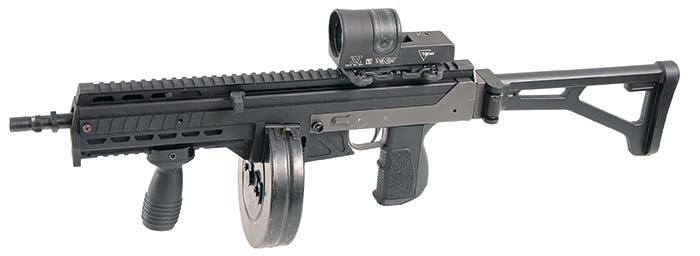
Ingram had noted that most of MAC’s customer emphasis was on sound suppressed weaponry. The 9mm Parabellum cartridge was not considered for his new M11, because of the cartridge’s inherent supersonic velocity. The only way yet devised to eliminate the sharp sonic crack of standard 9mm ammunition, was through the use of cartridges loaded to maximum velocity of 955 feet per second. The 9mm Parabellum so loaded used a 130-grain full-jacketed bullet, originally intended for the .38 Colt Super rounds. The .380 was considered to be as effective as the 9mm rounds of the era that were downloaded to achieve subsonic velocity.
Gordon Ingram’s Model 11 was originally intended to be offered as an alternative to the `Model 10 as a smaller, more concealable weapon. The M11 was designed specifically for use with a sound suppressor for “special” operations. In addition to its subsonic velocity the small .380 ACP round also produced less felt recoil and made the little submachine gun, even with a cyclic rate of fire of 1,600 plus rounds per minute, easy to control. To enhance the effectiveness of the .380 ACP cartridge a special loading utilizing a heavier projectile was developed, the cartridge was designated the MAC .380 SMG. This special loading replaced the standard 95-grain FMJ projectile with a more effective, yet still subsonic, 130-grain bullet. The bullet was the same as that used for the MAC subsonic 9mm rounds, with the same muzzle velocity of 955 feet per second. Original lots were made by the MAC loading department in commercial cases, and later by Winchester with a “380 SMG” head stamp. Because of its ability to accurately spray projectiles onto a target, the potent little M11 has often been referred to as a .380 caliber shotgun.
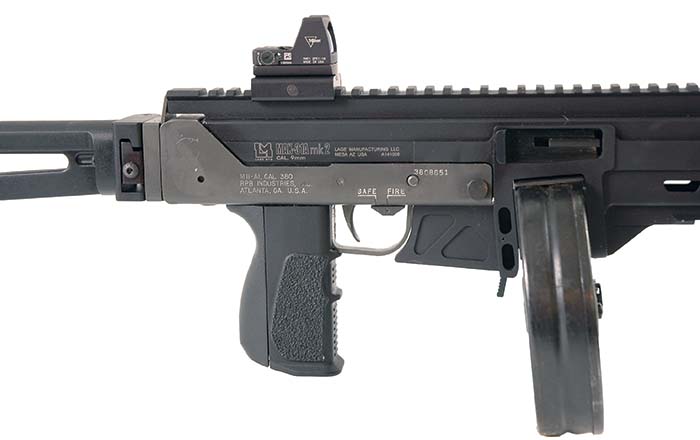
One experimental Model 11 was produced in 9mm Parabellum at MAC, but the weapon was never placed into production. Early Model 11, .380 caliber submachine guns manufactured at the Military Armament plant were marked 9MM AUTO, this caused a lot of confusion with customers in the U.S. and South America who were attempting to load and fire 9mm Parabellum rounds in their .380 caliber M11 submachine guns. After a brief period, a letter “K” suffix was added. The 9MM AUTO K represented “Kurz” or “short”, a designation commonly used in Europe. The .380 round was also known in many foreign countries as the 9mm Browning Short or 9mm Corto. The addition of the letter K did not completely solve the problem. To finally address the caliber confusion situation, subsequent production M11’s were marked .380 CAL. Some of the Military Armament Model 11 submachine guns have an oval shaped spot milled out of the receiver and marked .380 CAL in that area. It has often been reported that the 9MM AUTO K logo was removed, but this was not the case. When first attempting to mark the M11s with a .380 CAL marking, a worker transposed the numbers; the M11s had been mistakenly marked .308 (as in the 7.62×51 NATO cartridge). The .308 is the caliber marking that was removed by milling and changed to read .380 CAL.
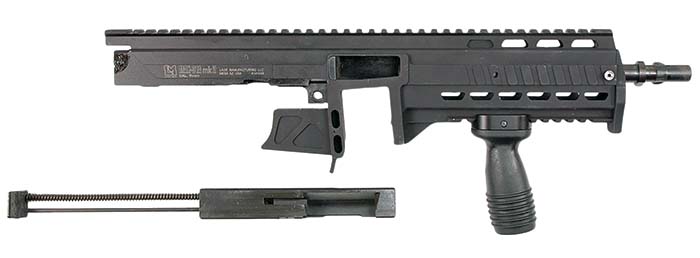
The SWD .380 M11-A1
After the demise of MAC and RPB, SWD introduced a .380 caliber version of their M11/Nine submachine gun designated as the M11-A1, which was essentially a shortened M11/Nine frame and receiver. As with the earlier MAC and RPB Model 11 .380, the 9mm models were more popular and produced in much larger numbers. The SWD M11-A1 receiver’s right side was marked; M11-A1, CAL .380; SWD INCORPORATED; ATLANTA, GA. U.S.A. The SWD-style encircled Cobray emblem was stamped at the top rear corner, and occasionally on the buttstock. The Cobray logo on the original MAC/Ingram Model 11 and the RPB M11-A1 was not encircled and did not include the name Cobray at the bottom. There are a few minor design differences between the original .380 caliber MAC/Ingram M11, RPB M11-A1 and the SWD M11-A1 variant. The primary difference is that the SWD M11-A1/.380, like its counterpart the M11/Nine, uses Zytel magazines. In order to accommodate the dimensionally larger Zytel magazine, the SWD M11-A1 magazine well was made larger than those on MAC and RPB M11 models. The steel magazines from the original MAC M11 and RPB’s M11-A1 submachine guns are not interchangeable with those of the SWD M11-A1 model. The SWD model has two dimples pressed into the side of the receiver to limit the rotation of the SEMI and FULL mode of fire selector lever to 180-degrees. The front of the magazine has a rather short bead of weld attaching it to the trigger guard; the back of the magazine well is welded to the receiver, hidden by the plastic grip extension. The grip extension also has the SWD style encircled Cobray logo molded into it.
The steel magazines of the earlier MAC and RPB .380 caliber Model 11’s won’t fit or function in the later manufacture SWD .380 caliber M11-A1, likewise the SWD Zytel magazines won’t fit in a RPB or MAC M11/.380. However the Lage MAX 31A is compatible with either model because the original magazine well is not used.

The MAX 31A
The pistol-size .380 caliber Model or MAC 11 wasn’t produced in the same numbers as the Model 10 or SWD’s M11/Nine submachine guns. As a result of the Model 11’s very limited production, aftermarket upgrades and enhancements to increase its ergonomics and decrease its cyclic rate have been few and far between. The M11’s .380 cartridge, less common in large quantities than the 9mm round, have also contributed to its lack of popularity. Most modifications in the past were to convert the Model 11 to fire 9mm rounds, although most attempts have been unsuccessful. The 9mm round was simply too powerful for the M11’s small frame and short bolt travel.
Richard Lage’s recently introduced MAX-31A Mk2 upper receiver has many attributes; one of them is successfully converting the Model 11 from .380 caliber to 9mm, and it’s designed to feed from both the high capacity, 71-round Suomi M31 drum magazines, and the Suomi 50-round duplex magazine more commonly known as the “coffin” because of its shape. The longer receiver converts the M-11 and M11A1 into a carbine sized submachine gun and provides greater control and handling. Features include a 16-inch long accessory rail on top and hard mount points for additional M1913 rails on right and left sides of front handgrip, the bottom rail is integral. Contained within the upper receiver is a heavy weight bolt assembly with a longer length of travel than the stock M-11A1 upper receiver. This reduces the rate of fire (ROF) from 1,500+ rounds per minute with .380 ACP ammo down to around 770 rounds per minute with 9mm ammo. Due to the reduced cyclic rate and longer bolt travel, muzzle rise is reduced; the gun feels much smoother in operation and easy to keep on target. The MAX-31A Mk2 easily attaches to the stock M-11 and M11A1 without any modifications to the lower receiver.
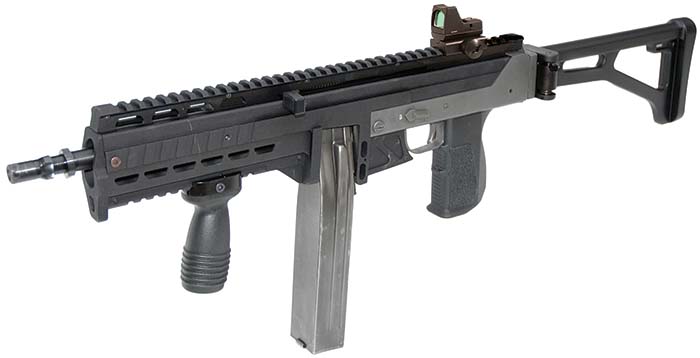
Options
The Lage MAX-31A Mk2 comes standard with an 8-3/8-inch barrel with 1/2-28 muzzle threads and a 9mm bird cage flash hider. For those desiring a different muzzle thread, Lage offers as an option 8-5/8 inch barrels threaded 3/4-10 at the muzzle for use with the original “old school” MAC or SWD 9mm suppressors. Also available is a 8-3/4 inch barrel with a HK type 3-lug mount. All Lage barrels are made from 4140 chrome-moly steel and finished in black oxide.
The VBS is a Variable Buffer System consisting of one buffer spacer. When installed in the MAX-31A Mk2, the rate of fire can be easily increased. The VBS easily installs on the bolt assembly by simply installing it between the rubber buffer and the back of the bolt assembly. It is securely held in place with the ejector rod.
Other accessories available at extra cost include both fixed and side-folding buttstocks made of black polymer in a choice of lengths to fit any shooter. A collapsible buttstock with a fixed polymer butt plate is also offered. All stocks have a provision for attaching a sling.
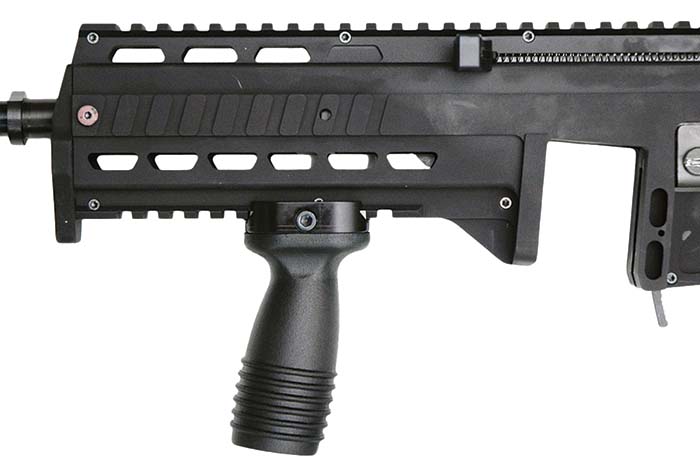
The optional two-piece molded polymer grip features a finger groove, a ribbed front and stippling on the sides. The rounded backstrap is more comfortable than the stock grip and extends lower. The bottom of the grip features a funnel shape on the bottom to facilitate faster magazine changes. A second grip is available with the addition of a lever above the grip to activate the heel mounted magazine release. The grip is the same as the standard two-piece molded grip except it has an internal mechanism to activate the heel mounted magazine release with a thumb actuated lever at the top of the grip. When used with “drop-free” magazines, you will be able to drop the empty magazine while reaching for a replacement magazine. The grip is available for the both the MAC/RPB and the SWD M11/.380 models
A vertical K-Grip is designed to attach to a M1913 Picatinny type rail. The canted angle allows a natural shooting stance that is more comfortable than a straight vertical grip. The clamp is made from 6061 aluminum and finished in black anodize. The grip portion is made from black polymer.
For those who need additional rails for attaching accessories to the sides of the upper receiver such as flashlights or lasers, Lage offers left and right side mount rails made from 6061 aluminum and finished in hard coat black anodize.
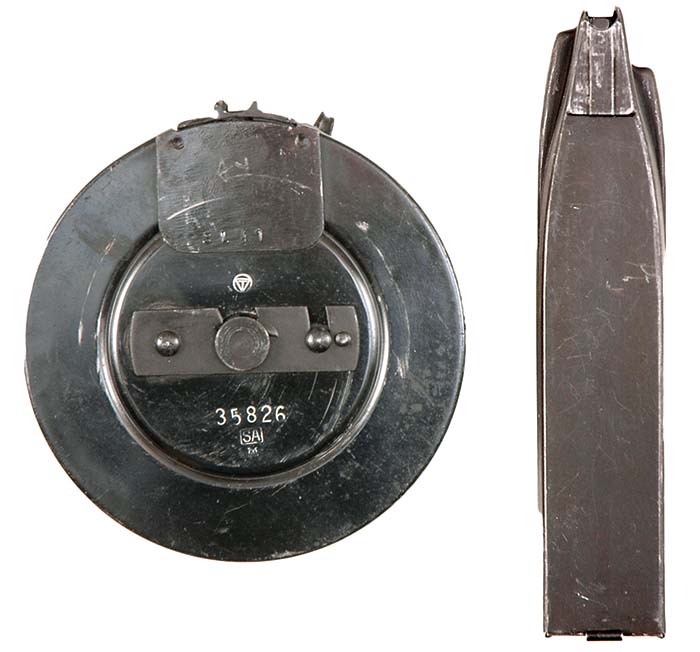
Other available products include an extended safety lever that mounts at the front of the trigger guard. The lever makes it quick and easy to positively engage and disengage the safety on a MAC, vital for use in subgun competitions. Also available is an internal safety slide that is designed to have more bearing surface and is made from steel with a black oxide finish. It is designed to replace the original slide that is made of cast aluminum.
Also available for the MAX 31A are several competition triggers, an improved extractor, a hardened sear, extended safety lever, buffers and extended cocking handle.
Overall dimensions of MAX-31A Mk2 upper receiver:
Length: 21-5/8 inches
Width: 1-1/2 inches (2-1/4 inches across cocking knob)
Height: 4-11/16 inches
Weight: 3 pounds 11.7 ounces
Overall dimensions of the MAX-31A Mk2 when assembled to an M-11A1 lower receiver with an 8-7/8 inch stock:
Overall length with 8-7/8 inch stock: 28 inches
Height: 6-1/2 inches
Width: 2-1/4 inches
Weight unloaded: 5 pounds, 13.7 ounces
Weight of 72rd drum magazine: 2 pounds, 2.5 ounces

Sources:
Gordon Ingram, the MAC MAN
Chipotle Publishing LLC
Phone: (702) 565-0746
Web: https://www.smallarmsreview.com
Lage Manufacturing LLC
Phone: (480) 219-8893
E-Mail: Sales@max-11.com
Website: http://www.max-11.com/
Suomi Drums
Tom Wright
Email: Vegasdrums31@gmail.com
Coffin magazines
Folke Myrvang
Email: folkem@online.no
| This article first appeared in Small Arms Review V19N6 (July 2015) |












